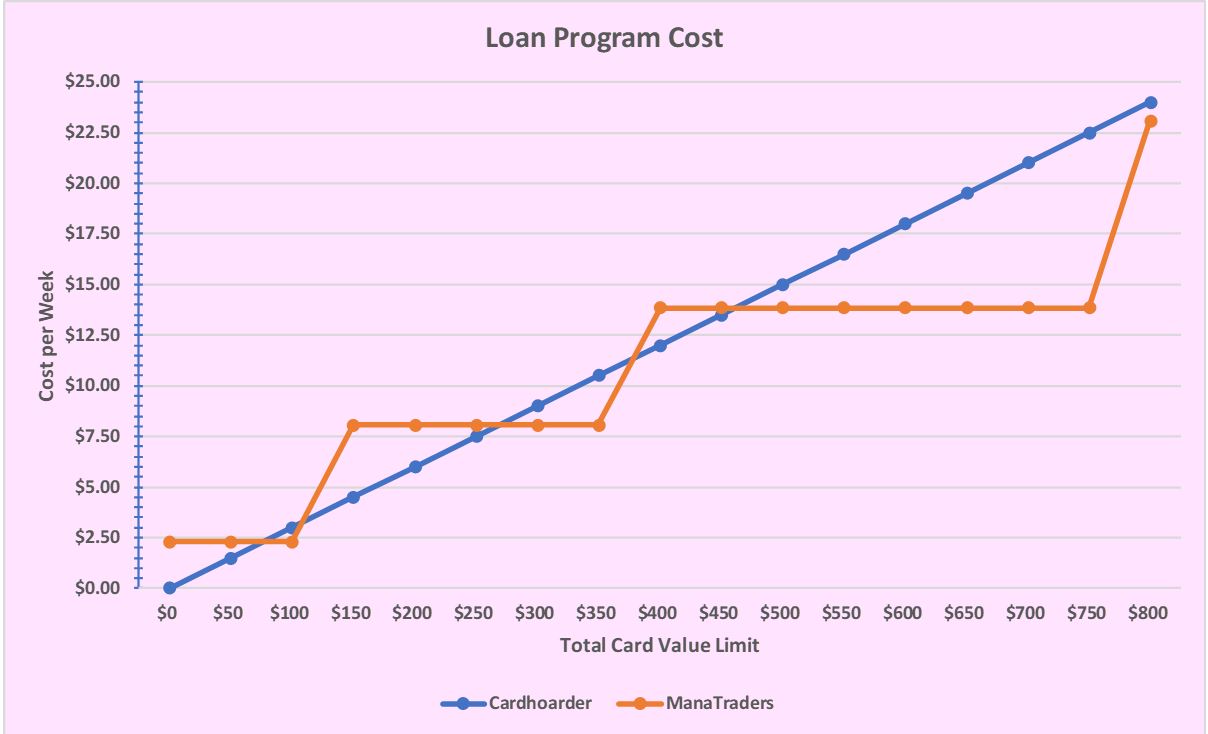Are you a Quiet Speculation member?
If not, now is a perfect time to join up! Our powerful tools, breaking-news analysis, and exclusive Discord channel will make sure you stay up to date and ahead of the curve.
Welcome back folks,
In my last article, I covered the basics of renting: what renting on MTGO is, how to go about doing it, what companies you can rent cards from, and how much renting generally costs. Today, I'd like to go a little more in-depth and discuss the pricing and perks of the plans that Cardhoarder and ManaTraders offer, so that you can determine which might best be useful for you.
I. Cardhoarder and ManaTraders: Compared
Cost:
The cost to rent through Cardhoarder and ManaTraders varies based upon the card value limit you choose to set. Note that the Cardhoarder and ManaTraders subscriptions cost an amount of money based upon your card value limit, not upon the value of the cards you are renting at any given time. I have generated a graph below that tracks how much it costs to rent from each service as your card value limit increases. This should help you decide which service to use.

While the graphs of Cardhoarder and ManaTraders generally track each other, they do differ. Much of this difference comes from the fact that Cardhoarder lets you set your own total card value limit and charges a flat 3% per week of that (hence the linearity of the blue line), whereas ManaTraders offers specific plans with specific total card value limits (the bottom horizontal orange line represents the "base plan", the second the "premium plan", the third the "gold plan", and the fourth the "ultimate plan").
The company whose point is lower on the graph for any given total card value rented offers the cheaper plan at that point (lower is better).
Some notable cost differences:
If you're renting small amounts, Cardhoader will be cheaper. If you're renting large amounts, ManaTraders will be cheaper.
On the lower end of the scale, Cardhoarder will be cheaper if you want a rental limit of $76.67 or below. This means that if you play Pauper decks exclusively, or if you're only renting a few cards from a more expensive deck in a different format, Cardhoarder is likely the cheaper option for you. Similarly, if you want a rental limit of $461.67 or higher, ManaTraders will be the right choice for you. This is a great option for those who want to be able to access any Modern or Legacy deck for a given period of time, since some of those formats' most popular decks can reach $600 or $700 in value.
If your ideal rental limit is between $76.67 and $461.67, however, at various points Cardhoarder will be cheaper and at others ManaTraders will be cheaper. As a general rule of thumb, if you want your rental limit to be at or just below one of the limits ManaTraders offers for its plans in this range ($100 limit for Basic, $350 limit for Premium), then ManaTraders will be cheaper. Otherwise, Cardhoarder will be cheaper (especially in that $150-$200 range). This should make intuitive sense - if you don't sense that you're maximizing your ManaTraders subscription plan, then it's likely that Cardhoarder will be the better plan for you.
Features:
There are, of course, other considerations besides monetary value. The perks of joining each company's loan program differ and could be more or less valuable to you depending on your playing habits.
One is the time it takes to join the loan program. ManaTraders has an edge here, as there is no waiting list. Cardhoarder has a waiting list of about 30 days.
Both Cardhoarder and ManaTraders are flexible about taking time off. Cardhoarder offers no loyalty benefits - you pay a weekly fee equal to 3% of your rental limit, and you can pause or unpause your account at any time. Cardhoarder's loan program really is that simple. I think one major appeal to Cardhoarder's loan program is how simple it is - it makes it very simple to use if you don't play MTGO all that often or are a frequent but sporadic user.
ManaTraders's loan program is more complex because loyalty rewards are a core part of their plan. Like Cardhoarder, ManaTraders lets you pause or unpause your account at any time, but you can only pause or unpause your subscription so often if you want to keep accruing loyalty. ManaTraders's loyalty rewards system makes it a more appealing service for someone who is a committed and regular MTGO user.
ManaTraders's loyalty rewards are real and substantial. It takes a long time to reach the maximum rewards level (24 months), but they have told me that in the coming month they are going to front-load their rewards, meaning that you'll be able to attain a high reward level after just 6 months of use.
The flagship loyalty rewards include the ability to increase your rental limit and possess the cards you rent for longer (unlike Cardhoarder, ManaTraders uses a system called "ManaHours" that strongly incentivizes you to return cards whenever you aren't logged in playing with them). The biggest reward of all, in my opinion, is that the cost of your subscription gradually decreases over time! After 24 months of active use, your subscription will cost 25% less, which is a big deal.
Some lesser perks include a guaranteed minimum ticket buy price of $0.90 in case you want to convert some of your tix to cash, and access to new Standard cards a day after their MTGO release. Currently, for most users, Coardhoarder and ManaTraders offer cards from a new Standard set about a week after that set comes out on MTGO.
ManaHours
Unique to ManaTraders is a ManaHours system, which is a system that ManaTraders uses to encourage subscribers to return cards they aren't currently using. For every hour you have your cards out, you accumulate ManaHours. For the ManaTraders Basic plan, you can keep your cards for 150 hours if you're renting the full $100 worth of cards (~4.9 hours/day), and for the Premium plan you can keep your cards for 71 hours if you're renting the full $350 worth of cards (~2.35 hours/day).
One major perk of Cardhoarder's loan program is that you don't have to worry about ManaHours. You can just hold your cards for as long as you're renting them.
Thus, while ManaTraders's loan program is good for persistent and active MTGO users, there is a certain activity level where it make sense for someone playing a lot to sign up for Cardhoarder, especially if they'd be enlisting for the Premium plan with ManaTraders. The Basic and Gold plans likely offer enough ManaHours for most users, but some grinders would run into trouble with the Premium plan.
II. Which Should I Choose?
For some, the decision will be easy. If you are wanting to rent cards whose value totals $460 or higher, then ManaTraders will be right for you. If you are someone who only wants to rent cards whose value totals $75 or less, then Cardhoarder will be right for you.
For those wanting to rent cards whose value totals something in between (a majority of people, I imagine), then the decision isn't quite so simple. Both companies have good customer support and are reputable. I think your decision will likely need to be based on cost and features. Which plan will be cheaper for me, given the rental limit you want? Am I a consistent-enough renter to build loyalty with ManaTraders's loyalty rewards program? Am I likely going to run over ManaTraders's manahour limit? These are the three important questions to ask yourself.
Cardhoarder's program is simpler, with no extra frills, which should appeal to those who engage with MTGO less frequently. ManaTraders's program is more involved, but the complexity that comes with that is easier to handle if you play on MTGO and use the service regularly.
Either way, you're getting way more value than the other MTG subscription service in town - the Magic Arena $15/month subscription that lets you play Brawl.
III. Signing Off
I hope this article was helpful and demystified some of the complexities of the two loan programs. In my next article, the last of this series, I will discuss how renting can be useful for players and investors who already have an MTGO collection; renting is a tool that can be used by everyone who plays Constructed! Feel free to leave any questions or comments down below, or hit me up on Discord!










